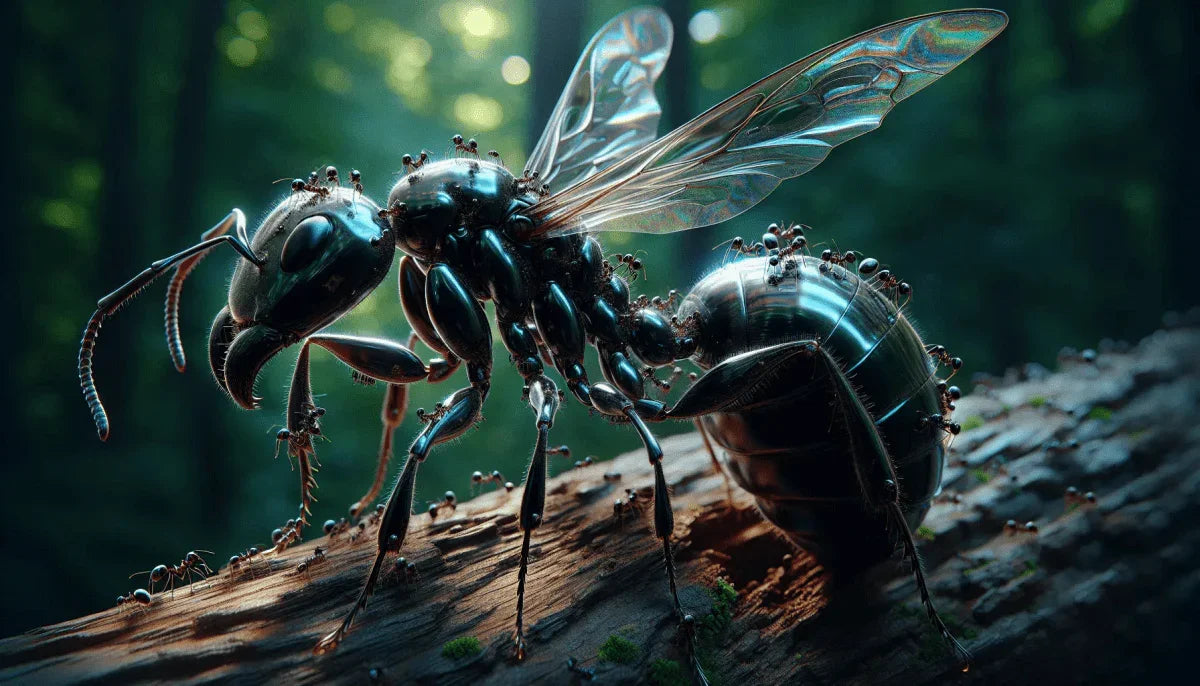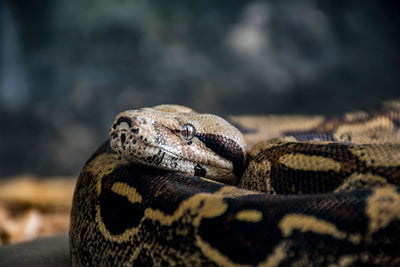Understanding the Carpenter Ant Queen

The queen reigns supreme in the complex society of a carpenter ant colony. Her primary role is to lay eggs, ensuring the colony's growth and continuity. Contrary to popular belief, she is not the ruler in terms of directing the colony's daily activities, but rather the cornerstone of its existence. Misconceptions also arise about her size and lifespan, which vary significantly from those of her workers and require a detailed understanding to dispel.
Identifying the Carpenter Ant Queen
At the heart of every carpenter ant colony resides its most pivotal member—the queen. The queen is the cornerstone of the colony's success and longevity. Recognizing the queen among her subjects is vital for understanding and managing these industrious insects. Carpenter ant queens possess distinctive features that set them apart from the workers and males of the species.
One of the most noticeable characteristics of a carpenter ant queen is her size. Significantly larger than the worker ants, the queen's impressive stature is the first clue to her identity. Her coloration can also serve as an indicator; queens often display a darker hue compared to their offspring and workers, although this can vary among species.
It's not just the queen's size and color that reveal her royal status; her anatomy plays a crucial role as well. Unlike worker ants, queens have larger and more developed thoraxes—the body segment just behind the head—which house the muscles necessary for wing movement. These wings, which are shed after their nuptial flight, are a visible sign of a queen's reproductive role in a colony's lifecycle. The queen's abdomen is also more prominent, designed to lay the hundreds, if not thousands, of eggs that will ensure the colony's future.
The queen's role extends far beyond egg-laying; she is the progenitor of the colony, and her well-being is paramount to the survival of her kin. Without the queen, a carpenter ant colony cannot replenish its numbers and will eventually perish. Thus, identifying and understanding the queen's role is not only fascinating from a biological standpoint but also crucial for effective ant control strategies.
Carpenter Ant Queen Biology & Anatomy
The biology of the carpenter ant queen is a captivating study, central to the survival and proliferation of her colony. Unlike the industrious workers, the queen’s primary function is reproductive. Within the bustling society of ants, she lays the foundation for future generations. The queen begins her life as a winged ant, embarking on a nuptial flight to mate. Once she has successfully mated, she sheds her wings and dedicates her life to egg-laying, a process she is remarkably designed for with an enlarged abdomen housing her reproductive organs.
The lifespan of a carpenter ant queen is impressively long compared to other ants, often living several years, a testament to her role's significance. Her behavior is guided by the needs of her colony, spending most of her existence within the nest's protected chambers, laying eggs that will become the next workers, soldiers, or reproductive ants.
Anatomically, the queen is a marvel of nature's design. Her adaptations are specific to her role within the ant hierarchy. The queen possesses a more robust and larger body than her offspring, facilitating the storage of energy and resources required for her prolific egg-laying. This distinctive morphology makes her easily identifiable among the members of her colony and underlines her importance to the colony's continuity.
The Lifecycle of a Carpenter Ant Queen
The journey of a carpenter ant queen is a saga of transformation and tenacity, pivotal to the prosperity of her colony. From the moment she takes flight to mate until the day she establishes a new stronghold, her role evolves continuously, orchestrating the growth and survival of her lineage.
Initially, the queen embarks on a nuptial flight, a maiden voyage into the sky filled with potential mates. It is here, amidst the aerial dance, that she mates with several males, storing the sperm to last her a lifetime. Post-mating, the queen sheds her wings, symbolizing the commencement of her new life grounded in the responsibility of founding a colony.
After the nuptial flight, her primary mission becomes the location of a suitable nesting site. She settles in damp wood or beneath soil, laying the first batch of eggs with the meticulous care of a sovereign ensuring her dynasty's continuity. The first eggs are precious, destined to become the worker ants that will serve as her initial retinue and caretakers of the brood to follow.
As larvae hatch and pupate, the queen's role transitions from the colony's sole provider to its beating heart. She becomes a prolific egg-layer, her body a cradle of life, while her offspring forage and expand the nest. During this phase, she is the colony's architect, laying the foundation for a complex social structure that will thrive under her guidance.
Over time, the colony swells in numbers, and her subjects diversify, assuming roles as workers, soldiers, or even future queens and males. Her presence is a constant, an embodiment of the colony's identity and success. The queen's longevity and health directly reflect the colony's strength, as she can live for several years, continually supporting the ant population's cyclical renewal.
The lifecycle of a carpenter ant queen is an epic tale of nature's ingenuity, with each queen a testament to the resilience and complexity of these social insects. Her role is a cornerstone, not just within the narrow confines of her colony, but in the broader ecosystem where her progeny will venture, shaping the environment in subtle yet profound ways.
Carpenter Ant Colonies and Their Queens
In the intricate society of carpenter ants, the queen occupies a pivotal role, serving as the cornerstone around which the entire colony is structured. Unlike the worker ants whose duties revolve around foraging, caring for the young, and defending the nest, the queen's singular, critical purpose is to lay eggs. Her ability to reproduce ensures the colony's expansion and survival, making her the most valued member of the ant community.
After a nuptial flight, a fertilized queen establishes a new colony, often in moist wood where she remains hidden, devoting her life to laying thousands of eggs. The survival of the colony hinges on her health and productivity. Should anything happen to the queen, the colony, devoid of its egg-laying cornerstone, would eventually decline and perish. This is why understanding the role and significance of the queen is essential for effective carpenter ant control measures.
For those dealing with a carpenter ant infestation, it is this reproductive capability of the queen that presents the greatest challenge. Addressing the issue often requires a comprehensive strategy that includes locating the nest, which is no small feat given the queen's preference for concealed spaces. Professional pest control services understand the significance of the queen and focus their efforts on strategies that directly affect her, thereby ensuring the long-term success of their ant control measures.
How to Identify a Carpenter Ant Queen Among the Colony
Within the bustling society of a carpenter ant colony, the queen holds a pivotal role, her presence critical to the colony's growth and survival. Distinguishing this regal insect from her subjects is key for understanding and managing carpenter ant populations. One of the first indicators of a queen is her size; she is considerably larger than the workers and males in the colony. Her abdomen, designed to lay hundreds, if not thousands, of eggs, is more voluminous and robust.
Another telltale sign of a queen is her wings—or rather, the lack thereof. After a nuptial flight early in her life, a queen will shed her wings, a process known as "dealation." In contrast, worker ants never develop wings, and males, who also possess wings for mating purposes, are smaller and have a shorter lifespan. The queen's thorax, where the wings were once attached, may bear scars or stubs, evidence of her past as a fertile flyer.
Encounters with a queen are rare, as she spends most of her time within the depths of the nest, enveloped in the care of her loyal workers. However, during the colony's founding stage, or if the nest is disturbed, you may catch a glimpse of her. Typically found in moist and decaying wood, carpenter ant queens establish their initial nests in secluded, protected locations. If you're investigating a potential infestation, it is during the spring and early summer months, when new queens are looking to establish new colonies, that you might spot one.
Identifying a carpenter ant queen is more than an exercise in curiosity; it's a crucial step in effective ant control. Recognizing the queen's importance can assist homeowners and pest management professionals alike in targeting the heart of the colony, ensuring a comprehensive approach to carpenter ant mitigation. Armed with these insights, individuals can better understand the dynamics of these industrious ants and the necessary steps to protect their homes from unwanted wooden excavations.
Carpenter Ant Queen Treatment & Damage Control
The core of a carpenter ant colony's vitality lies with its queen. The presence of a queen is paramount to the sustenance and expansion of the colony, making her the primary target in pest control strategies. Queens are responsible for laying thousands of eggs, thereby bolstering the population within your home. A carpenter ant infestation, left unchecked, can lead to significant structural damage as their nests expand within woodwork and moist areas.
Effective control of carpenter ant populations necessitates a dual approach: direct treatment methods and preventative strategies. One of the direct approaches includes baiting systems that target foraging workers, which in turn carry the bait back to the nest, effectively reaching the queen. Another common treatment is the use of insecticides, which are applied in strategic locations where ants are likely to travel. Insecticidal dust is especially effective as it can penetrate deeper into the wood where the queen may reside.
Preventative measures, however, are equally crucial to ensure the queen doesn't re-establish her colony. This includes maintaining dry conditions in and around your home, sealing entry points to prevent ants from accessing the structure, and removing potential food sources that attract ants. Regular inspections by pest control professionals can also help identify potential issues before they escalate into significant problems.
Understanding the central role of the carpenter ant queen in colony establishment and expansion allows homeowners to focus control efforts effectively. By combining both direct treatment and preventative measures, the likelihood of long-term success in managing carpenter ant infestations is greatly increased.
Preventing Carpenter Ant Queens from Establishing Colonies
As homeowners or property managers, taking proactive steps to prevent the establishment of carpenter ant colonies is crucial. The presence of a carpenter ant queen signals the potential start of a new colony, which can lead to significant structural damage over time. A key strategy in preventing these colonies lies in addressing the conditions that attract these ants in the first place.
Moisture control stands out as a critical preventative measure. Carpenter ants are drawn to damp wood, which provides an ideal environment for the queen to lay her eggs and establish a new colony. Ensuring that any leaks in the roofing, plumbing, or other areas are promptly repaired can diminish the allure of the habitat for these pests. Additionally, proper ventilation in attics, basements, and crawlspaces is essential in keeping these areas dry and less hospitable to carpenter ants.
Beyond moisture control, other preventative strategies include sealing potential entry points around the home. This could involve caulking gaps around windows and doors or ensuring that foundation cracks are properly sealed. It's also important to store firewood away from the home's structure and to keep tree branches trimmed back from the roofline, as these can serve as bridges for ants to enter the home.
By employing these preventative measures, homeowners can significantly reduce the likelihood of a carpenter ant queen establishing a new colony. Vigilance and regular maintenance are the best defenses against these industrious insects.
The Orkin and Terminix Approach to Carpenter Ant Control
When it comes to safeguarding our homes from the silent and often unseen threat posed by carpenter ants, especially the queen which is pivotal to the colony's growth, two names stand out in the pest control industry: Orkin and Terminix. Both companies have established a reputation for comprehensive pest management solutions, yet their strategies in addressing carpenter ant infestations showcase their unique methodologies.
Orkin, with its century-old legacy, approaches carpenter ant control with a blend of science-based methods and local expertise. They concentrate on a customized solution that begins with a thorough inspection to identify the extent of the infestation and the specific species involved, especially the elusive queen ant. Terminix, on the other hand, boasts its rapid response and innovative technologies to halt carpenter ants in their tracks, focusing on immediate relief and long-term prevention.
Dealing with queen ants requires a nuanced understanding of carpenter ant behavior and biology. The queen's removal is critical because she is responsible for repopulating the colony. Both Orkin and Terminix emphasize the importance of professional assistance, acknowledging that do-it-yourself efforts may not be sufficient when facing the intricate challenge of locating and eliminating a carpenter ant queen. Their trained professionals use tactics that not only address the visible workers but also aim to reach the heart of the colony - the queen.
While the specific strategies of these industry leaders may vary, the underlying principle remains consistent: professional expertise is indispensable when it comes to effective carpenter ant control, particularly when the target is the queen, the linchpin of the colony. Homeowners are encouraged to reach out to such professionals to ensure that their home remains free from the structural damage that these pests can cause.
Talis-us Connection: Understanding the Importance of Expertise in Ant Control
When it comes to managing pests, particularly carpenter ant queens, the necessity for informed and effective solutions cannot be overstated. A clear understanding of the intricate behaviors and biology of these ants is crucial for successful intervention and control. Talis-us acknowledges this need by dedicating itself to providing high-quality, reliable information that empowers individuals to make informed decisions when addressing pest-related challenges.
In a landscape where carpenter ants can cause significant structural damage to homes, the expertise offered by Talis-us stands as a beacon for those seeking not just answers, but also proactive strategies. The company's approach is grounded in clarity and straightforwardness, mirroring the brand's commitment to guiding customers through the complexities of pest control with ease and certainty.
Talis-us leverages its platform to disseminate knowledge that extends beyond mere identification. It delves into preventative measures, ensuring that homeowners are equipped with the right tools and understanding to safeguard their spaces against these persistent invaders. By embracing this educational perspective, Talis-us fortifies its audience with the expertise necessary to tackle ant control with confidence and effectiveness.
Conclusion
As we reach the end of our exploration, we reflect on the vital information gathered about the queen of the carpenter ant colony. The queen is not only the progenitor but also the cornerstone of the colony's growth and survival. We've learned that identifying the carpenter ant queen is crucial, as her presence is indicative of a potentially expansive colony that could pose a risk to wooden structures.
It's essential to recognize the queen's significant role in the lifecycle of the colony. Understanding her impact is a critical step in implementing effective pest control measures. Should a queen establish her colony within the wooden crevices of a home, the structural integrity can be at risk. Therefore, addressing the presence of a carpenter ant queen goes beyond mere pest control—it's about protecting our homes and investments from unseen damage.
Remember, the key to successful pest management is not only in the thorough identification of these ants but also in adopting proactive strategies to prevent their colonization. As we've seen, recognizing and addressing the queen's role in the colony's lifecycle is paramount for long-term control and prevention.
Act Now Against Ants
As we've explored the fascinating world of the carpenter ant queen, understanding her vital role in the lifecycle and infestation potential within our homes has become clear. It's essential to be vigilant and proactive in identifying and managing these industrious insects. For enthusiasts eager to delve deeper into comprehensive pet care, we invite you to visit Talis-us . While our exploration today centered around carpenter ant queens, Talis-us offers a wide range of pet products, including ant accessories that cater to the curious minds and the well-being of our tiny friends.






